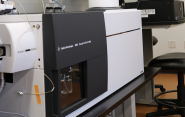A Yale Innovation from Two Historic Ones

For a recent study on the many variables that contribute to air quality, researchers drew from two historic innovations that stemmed from Yale Engineering to make a new discovery.
The lab of Drew Gentner took a close look at the molecular makeup of organic aerosols, which have a significant presence in the atmosphere but also pose health and climate risks. To get such a detailed profile, the research team used high-performance liquid chromatography (HPLC), which separates thousands of compounds in a sample. HPLC was an innovation of Csaba Horváth, a former Roberto C. Goizueta Professor of Chemical Engineering at Yale. Before Horvath, applications for liquid chromatography had been fairly limited since its invention 60 years earlier. Borrowing some ideas from gas chromatography, Horvath turned the technique into one of the most used separation techniques in chemistry and biochemistry.
Another major component to the study is a mass spectrometer, the technology of which benefits greatly from John Fenn, another Yale pioneer. Fenn, who was a professor of engineering at Yale, was awarded the Nobel Prize in Chemistry in 2002 for developing a technique known as Electrospray Mass Spectrometry (ESMS). One of the breakthroughs that resulted was a much better way to study molecules.
“In our study, we combined the technology that Czaba Horvath developed with the technology that John Fenn developed,”said Gentner, assistant professor of chemical & environmental engineering. “The combination made it possible to produce what I would say is an unprecedented non-targeted analysis of atmospheric aerosol.”
What they found was that the makeup of their air samples was a lot more complex and varied than previous studies suggested. The results were published in Nature’s Communications Chemistry (read more about it here). The researchers obtained air samples from a research tower in a northern Michigan forest to downtown Atlanta, Ga. (a city close to forests, which makes it a good spot to find both biogenic and anthropogenic aerosols), and to New York City (a good location to study organic aerosol from anthropogenic sources).
"We built a compact sampler to collect aerosols on Teflon filters, which we deployed at each of the three field sites,” said Jenna Ditto, a Ph.D. candidate in Gentner’s lab and lead author of the study. “We collected samples across eight-hour periods during the day and at night, to look at different chemical products that form in light and dark conditions."
In addition to the study, Gentner and Ditto wrote a companion piece for the journal that describes how the study developed.

